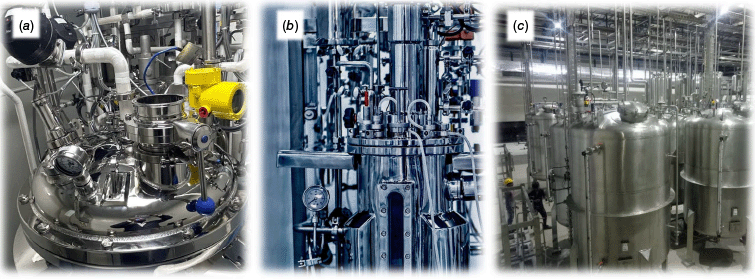Precision fermentation: a new ‘thing’ or just a new name? Current status locally and globally
Samantha Sawyer A B * and Tom Ross BA
B

Dr Samantha Sawyer is a board secretary of FermenTasmania, which is a not-for-profit building a hub in Launceston, a UNESCO City of Gastronomy, for fermentation businesses to research, innovate and develop small scale commercial products. Sam is passionate about application and commercialisation of research and has worked in industry and academia as a researcher in industrial biotechnology and precision fermentation, plant extractives and digitisation of food quality. She won a Science and Innovation Award 2022 and was a ‘Superstar of STEM’ (2023–24). She is an innovation specialist in the water industry and co-chair of the Australian Institute of Food Science and Technology (Tasmanian branch). |

Adj. Prof. Tom Ross is a food microbiologist specialising in mathematical modelling of the microbial ecology of foods. He remains an adjunct professor at the University of Tasmania. Tom has written >170 scientific papers and book chapters. He contributes to expert committees on science-based food safety management for Australian government and industry organisations, and international organisations including the FAO and WHO. He serves on editorial boards of several international microbiology journals. Tom is energetic in communicating the potential of sound science into benefits for people and society. |
Abstract
Precision fermentation (PF) is a term used to describe the use of a range of technologies including genomics, biotechnology, synthetic biology, including Artificial Intelligence-centred to use microorganisms (bacteria, yeast, fungi) to produce food and food ingredients. The term was originally conceived in the context of more sustainable approaches taking over from traditional agriculture. Part of the rebranding is to enable clearer communication to consumers to gain their acceptance of PF foods and food ingredients. Start-ups and larger companies are developing new niche and specialty products using PF and, internationally, there are examples of commercial PF products (e.g. synthetic dairy milk in Denmark). Although these market examples are currently limited, there is enormous potential for growth of PF food and food ingredients as technological advancements and efficiency gains reduce cost of production. The market will continue to prove itself through higher value, lower-volume approaches to market entry and capitalisation with a view to broad acceptance and adoption.
Keywords: AI, artificial intelligence, biotechnology, carbon footprint, environmental sustainability, industrial fermentation, novel technological food production, safe food additives, synthetic milk.
The origin of ‘precision fermentation’
The term precision fermentation (PF) was first introduced in 2019 by a US-based not-for profit think tank called RethinkX with the idea to set PF apart from current applications of industrial fermentations due to their proposed use to replace traditional sources of food, such as crops or domesticated animals. In their publication Rethinking Food and Agriculture,1 RethinkX acknowledged that PF has been done for decades, starting with the introduction of the gene for human insulin into yeast cells, but chose to give it a new name. The kinds of ideas, and tools and technologies that underpin PF were previously termed ‘genetic engineering’, ‘biotechnology’ or more recently ‘industrial fermentations’, which is the intentional use of fermentation in large-scale manufacturing of fermented foods and chemical products. ‘Synthetic biology’ (and biotechnology and genetic engineering) further involves the application of existing organisms or redesign of existing microorganisms to produce desirable chemical and biochemical products is a closely related concept. Industrial fermentations were seen as an integration of natural sciences with engineering sciences to achieve applications of organisms, or parts thereof, for products and services.
These technologies have, over the last few decades, already given us new sources of insulin (formerly from pig pancreases), human growth hormone (somatotrophin), lactoferrin, rennin (chymosin, also formerly from calves) used in cheese making, as well as many industrial–domestic enzymes (e.g. cold active proteases for clothes-washing detergents) and for biopharmaceutical applications (e.g. vaccines, glucose isomerase for rapid blood sugar assessment tests).
The RethinkX vision, however, is not the same as the long-investigated idea of single cell protein as food supplements (think Vegemite or Arthrospira platensis, formerly known as ‘spirulina’, or Quorn). The RethinkX vision is to use PF to develop technologies to produce a vast range of food constituents that could then be assembled or combined by food technologists into a designed food to replace traditional, agricultural sources of food. In a way, this envisioning of PF is a parallel to the idea of cell cultivation but instead of using cultured cells to create a food, synthesising food components in microbiological bioreactors (Fig. 1).
Precision fermentation: at research scale (a), pilot scale (b) and commercial scale (c). (Images provided by, and used with permission of, FermenteQ Innovations, Inc., Vancouver, BC, Canada.)

To standardise nomenclature and reduce confusion for future consumers, Cellular Agriculture Australia proposed that PF is distinct from cell cultivation and cultivated meat and, rather:
harnesses microorganisms (yeast, bacteria, fungi) to produce specific ingredients that can be used in various food and agricultural products. The ingredients produced can include egg and dairy protein as well as specific enzymes, flavours, colours, fats and oils. [Cellular Agriculture Australia, Language Guide, pp. 16–172]
These may or may not be use genetically modified microorganisms. For example, smart brewing typically uses non-modified microorganisms for optimising flavour and other organoleptic properties. Conversely, recombinant microbial chymosin (rennin) for cheese manufacturing – a biotechnological alternative to traditional rennet derived from calf stomachs – is a well-established example that relies on genetically modified microorganisms.
What are the anticipated benefits of PF in food production?
Although the Rethink document may contain hyperbole, and reflect a level of hubris, and some naïvety about the reasons why we have the food production systems that we enjoy today (see https://www.rethinkx.com/food-and-agriculture, accessed 1 May 2025), it does make some relevant points about the ability of traditional agricultural practice to meet, sustainably and cost effectively, the food needs of a growing global population, expected to reach ~9 billion people before stabilising (see https://www.un.org/en/global-issues/population, accessed 25 May 2025).
The use of PF for food and food ingredient production is a more recent endeavour than other industries like pharma and fine chemicals. Whereas pharmaceutical ingredient products and industrial enzymes are usually ‘high value–low volume’, food and food ingredients are usually of lower value, and production volumes need to be higher for PF to be cost competitive. The economic viability will depend on demonstrating value to investors and consumers of the added value and unique benefits possible from PF. Recent developments and decreasing costs of bioreactors and development of facilities capable of higher volume production have helped to reduce these costs leading to food innovations some of which are exemplified below. Although this article is focused on the ‘microbial factories’, downstream processing following fermentation is critical for the preparation of commercial products, and developments in these technologies run parallel to cultivation for enabling the sector. We have listed exemplars in the PF products ‘category’ but there are still many technical, regulatory and market challenges to PF foods. These are comprehensively discussed elsewhere.3,4 Despite the challenges, there has been significant investment in the PF ecosystem specifically for food manufacturing, including start-ups, pilot and scale-up facilities, downstream processes to recover the desired products without extraneous microbial components, and market development both nationally and internationally.
‘Food software’ and libraries of ‘industrial workhorses’
‘Smart strain’ libraries have always been a key driver for PF along with the decreasing costs of bioreactors and the use of Artificial Intelligence (AI) for strain modification (e.g. through directed evolution or genetic modification). The creation and existence of screening libraries has accelerated progress for the food and beverage industry, e.g. by being able to identify organisms with different properties to be able to use singly or in mixed fermentations to achieve the desired set of products. Although screening libraries have similar considerations for PF upscaling and commercial production, they are mostly specific to the needs at each scale.
Library creation accompanied by high-throughput genomic screening has allowed many PF companies to create distinct products and offerings. For example, Amyris developed platform strains that could be modified with little effort to synthesise several target molecules (see https://amyris.com/, accessed 3 May 2025). One of their early successes was switching their proprietary strain from producing patchouli (mint) to producing santalols (found in sandalwood oils) in one step. In conjunction with scaled-down high-throughput screening of numerous potential candidate strains, Amyris has genetically engineered yeast to produce natural food ingredients such as steviol glycoside.
A newer approach has been to use AI for in silico design and to engineer new strains. Live Green have used their AI technology, Charaka, to replace animal-based ingredients, emulsifier, anti-freezing and anti-caking agents with plant-based or natural ingredients in ice creams (see https://de3pbio.com/, accessed 1 May 2025). They have found the substitution does not change the product’s taste, texture or mouthfeel over their test duration (90 days). Charaka uses deep learning to analyse thousands of compounds for organoleptic, taxonomic, phytochemical compounds, bioactive molecules, nutritional profiles, physicochemical and mechanical properties, and molecular analysis. Live Green are now turning that AI technology to access non-linear relationships and predict new functionalities and uses to develop new fungal workhorses to produce food ingredients sustainably.
Metabolic manipulation
Although process and workflow automation of bioreactors is not new, AI and machine learning are being used to optimise fermentations where sufficient data are available. With the decreasing cost of bioreactors and sensors for monitoring outputs of microbial metabolism, there is much higher throughput and variety of data generated to monitor fermentations. Companies like Pow.bio, FermenteQ, and Fermecraft have specialised in this area. Fermecraft is considered an Internet of Things (IoT) ‘intelligent automation system’ for Australian craft brewers, wineries and gin producers.
These IoT systems allow monitoring and automated control in real time over important fermentation parameters such as temperature, pH, gas production and off-flavour production. Newer methods to assess sensory quality, such as electronic noses and tongues, enable greater ability to control, manipulate and create desirable sensory experiences for consumers. The further development of AI technologies such as Agentic AI could enable dynamic control of ferments and AI suggestions for how to develop the flavours desired in PF. They could, in future, be customised to target specific market segments or even individual consumers.
Designer food and consumer acceptability
Communication with consumers to influence market perception of PF foods will be key to market acceptance with taste being an important consideration, e.g. comparison to foods already on the market (e.g. animal- and plant-based products) as well as health and safety, nutrition, environmental benefits and animal wellbeing.5
A study of consumer acceptance of PF liquid whole egg in Germany, Singapore and the USA found messaging to be important to manage demographic differences (including dietary preferences) across the three countries.6 Despite these differences, the PF alternatives for animal-based products garnered curiosity about the technical approach as well as health, animal welfare and price considerations. All of these are important considerations when creating alternatives to animal-based products. For example, Australian companies All G Foods and Eden Brew are creating liquid milk from whey proteins and casein. The ‘milk’ will have the functionality of cow’s milk because it can form micelles, but current formulations lack the nutritional properties of cow’s milk. Price point, in particular, is important as affordability and food security come into conflict with environmentally and ethically favourable outcomes.7 In Denmark, synthetic milk is already being made and sold and is being marketed as at least as wholesome and nutritious as traditional cow’s milk but with a much smaller environmental footprint (ReMilk, see https://www.remilk.com/, accessed 1 May 2025).
Businesses are managing the price differentials of PF foods, particularly to offset research and development expenditure, by employing various strategies for managing profitability while the cost of production remains high. A key approach is to target higher value food products which require lower volumes for sensory impact. For example:
– Impossible Foods incorporate haemoglobin made using PF to give their plant-based burgers the look and smell of cooked red meat.
– EvodiaBio is a startup making sustainable aromas for the food and beverage industry. They are producing monoterpenes from yeast.
– Nourish Ingredients is an Australian company targeting signature fats and oils in meat and dairy that create distinctive sensory attributes.
For many of these companies, sustainability is the main message for PF as an alternative to traditional agriculture offsetting current bottlenecks (e.g. climate resilience) and reducing waste. Although PF has a significant reliance on sugarcane as a typical feedstock, a number of companies have differentiated themselves based on alternative carbon sources and feedstocks, as well as using non-genetically modified organisms. For example:
– NovoNutrients – gas fermentation to produce protein.
– Clever Fruits – nutraceuticals with higher bioactivity from PF of fruit waste using proprietary strains.
– Kingdom Supercultures – assembles new cultures from their biobank to create new fermented foods and beverages with unique flavours.
– GreenTech Innovators – produces enriched growth medium for microbial cultivation from food waste.
Within the Australian context, FermenTasmania, alongside CSIRO,8 Cauldron (see https://www.cauldronferm.com, accessed 27 April 2025) and the Queensland Food and Beverage Accelerator (FABA, see https://faba.au, accessed 28 April 2025), are creating an Australian PF food ecosystem to enable strain research and development and upscaling of novel food and food ingredients using PF at multiple scales from small-scale (e.g. 1–2 L) through to large production scales (e.g. 10,000–25,000 L).9 Working with local companies, PF has enormous potential for the sustainable, customisable and ethical production of food and food ingredients.
Conclusions
Precision fermentation is just a new term for a range of technologies including genomics, biotechnology, genetic modification, synthetic biology, engineering and AI technologies that have been developed and integrated over the last 40–50 years but mostly for high-value, low-volume, largely biopharmaceutical products. The term ‘precision fermentation’ was originally conceived in the context of more sustainable technologies to feed the world’s growing population and take over from traditional agriculture, i.e. that based on domesticated animals and crop plants. In part, this rebranding underpins messaging for consumer acceptance of PF foods and food ingredients. Although there are some examples of this vision being realised (e.g. synthetic milk in Denmark), most applications for PF currently are niche and specialty products for use as food ingredients. Nonetheless, the idea of PF can be expected to progress as economies and efficiencies are achieved that will continue to reduce the cost of production and to become a workable alternative to traditional agriculture.
Data availability
Data sharing is not applicable as no new data were generated or analysed during this study.
References
1 RethinkX (2019) Rethinking Food and Agriculture 2020–2030. https://www.rethinkx.com/publications/rethinkingfoodandagriculture2019.en [accessed 30 April 2025]
2 Cellular Agriculture Australia (2024) Language guide: Cellular agriculture in Australia. Version 3.0, November 2024. CAA. pp. 12–13. https://www.cellularagricultureaustralia.org/publications/language-guide---cellular-agriculture-in-australia-v3
3 Marcellin E et al. (2024) Precision fermentation: a future of food in Australia. White Paper number 2, 12 November 2024. Innovative Ingredients Program, Australia’s Food and Beverage Accelerator, The University of Queensland. https://faba.au/wp-content/uploads/2024/11/Precision-Fermentation-A-Future-of-Food-in-Australia.pdf [accessed 28 April 2025]
4 Cellular Agriculture Australia (2024) Producing food through precision fermentation: the opportunity for Australia. August 2024. CAA. https://www.cellularagricultureaustralia.org/publications/producing-food-through-precision-fermentation---the-opportunity-for-australia
5 Thomas OZ et al. (2023) Not getting laid: consumer acceptance of precision fermentation made egg. Front Sustain Food Syst 7, 1209533.
| Crossref | Google Scholar |
6 Broad GM et al. (2022) Framing the futures of animal-free dairy: Using focus groups to explore early-adopter perceptions of the precision fermentation process. Frontiers in Nutrition 9, 997632.
| Crossref | Google Scholar | PubMed |
7 WeForum (2023) Global Risks Report 2023. Insight report. World Economic Forum, Geneva, Switzerland. https://www.weforum.org/publications/global-risks-report-2023/ [accessed 1 May 2025]
8 CSIRO (2025) Reimagining food using fermentation. https://www.csiro.au/en/about/challenges-missions/future-protein-mission/novel-protein-production-systems/precision-fermentation [accessed 28 May]
9 Augustin MA et al. (2024) Innovation in precision fermentation for food ingredients. Crit Rev Food Sci Nutr 64, 6281-6238.
| Crossref | Google Scholar |
 Dr Samantha Sawyer is a board secretary of FermenTasmania, which is a not-for-profit building a hub in Launceston, a UNESCO City of Gastronomy, for fermentation businesses to research, innovate and develop small scale commercial products. Sam is passionate about application and commercialisation of research and has worked in industry and academia as a researcher in industrial biotechnology and precision fermentation, plant extractives and digitisation of food quality. She won a Science and Innovation Award 2022 and was a ‘Superstar of STEM’ (2023–24). She is an innovation specialist in the water industry and co-chair of the Australian Institute of Food Science and Technology (Tasmanian branch). |
 Adj. Prof. Tom Ross is a food microbiologist specialising in mathematical modelling of the microbial ecology of foods. He remains an adjunct professor at the University of Tasmania. Tom has written >170 scientific papers and book chapters. He contributes to expert committees on science-based food safety management for Australian government and industry organisations, and international organisations including the FAO and WHO. He serves on editorial boards of several international microbiology journals. Tom is energetic in communicating the potential of sound science into benefits for people and society. |


